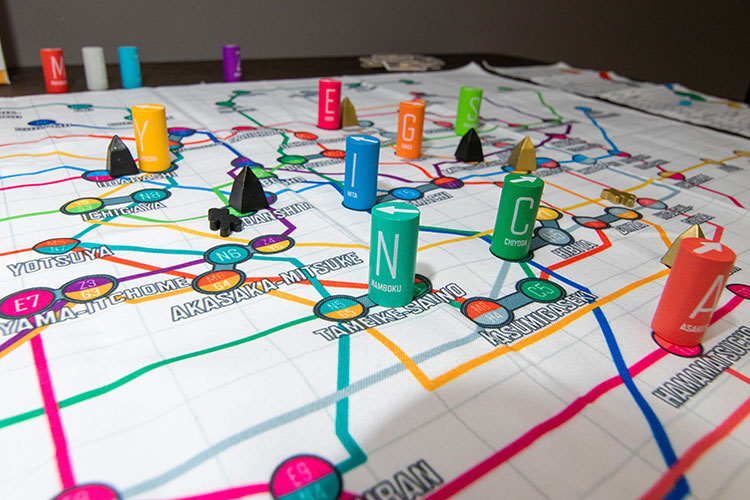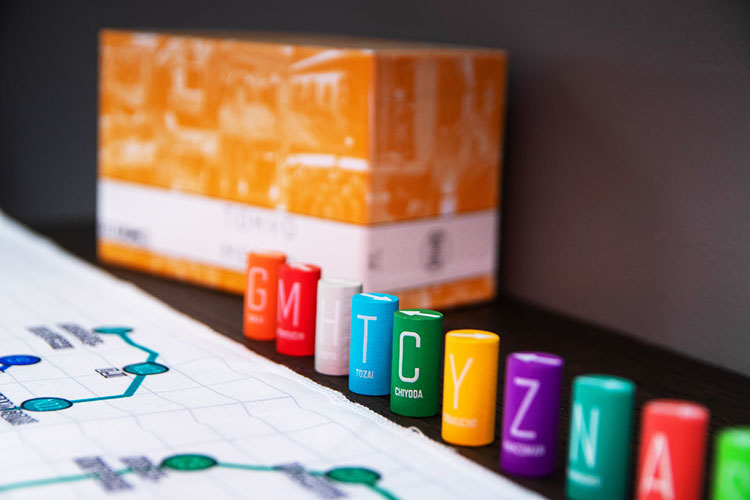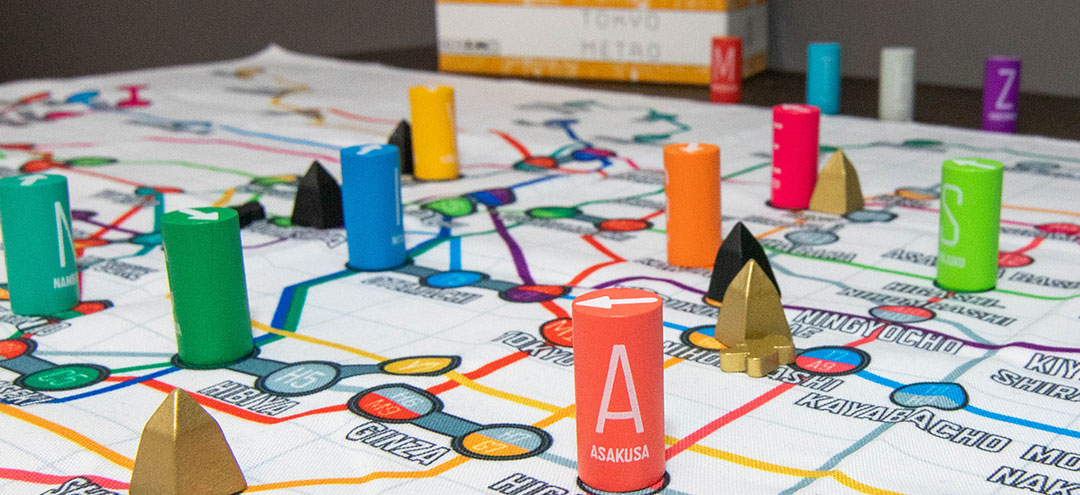 Today we are looking at the heaviest game in the initial Tokyo Series from Jordan Draper games. Tokyo Metro focuses on… well… the Tokyo Metro system. In this relatively small package you’ll find a very large game—a heavy economic worker placement game that will have players manipulating stocks in various train lines. While comparisons have been made to Winsome train games and even the heaviest of 18XX games, Tokyo Metro really blazes a bit of a different path altogether.
Today we are looking at the heaviest game in the initial Tokyo Series from Jordan Draper games. Tokyo Metro focuses on… well… the Tokyo Metro system. In this relatively small package you’ll find a very large game—a heavy economic worker placement game that will have players manipulating stocks in various train lines. While comparisons have been made to Winsome train games and even the heaviest of 18XX games, Tokyo Metro really blazes a bit of a different path altogether.
Tokyo Metro is a worker placement economic game that plays 1-5 players. It plays best with 4-5 players and takes about 2 hours.
Gameplay Overview:
Tokyo Metro revolves around investing in various train lines and building stations to earn money. Players will potentially invest in multiple companies, speculate in the success of others while moving around the map to develop the metro system. At the end of the game, all train company’s income is distributed to the investors and the player with the most money is the winner.
All of this is accomplished using a worker placement action selection. Each round there are 24 cards available with various actions and players will take turns placing an action disc and carrying out one of the possible actions. The most important actions to discuss are:
- Move: Move your meeple the indicated number of spaces
- Station: Place a station pyramid on a station that is adjacent to your meeple.
- Invest: Take stock in a train company of your choice, increasing its value by the amount invested.
- Start: Start a train running without investing. You get no stock, but the company value increases by the amount paid.
- Speed: Take a speed token. These can be placed on a train line to increase the number of spaces the train moves.
- Speculate: Speculate on any train line that another player has invested in.
- Loan: Take ¥1000 yen from the bank.

After all players have used all of their action discs, the train phase begins. Each train moves along its designated route five spaces. For each station it encounters, income is generated. If the station is owned by a player who is invested in the train line, the train company value increased by ¥500. However, if the station is owned by a player who isn’t invested, the train company only gets ¥200 and the station-owning player gets ¥200.
The game ends after seven rounds, when the action cards are exhausted. Speculations and investments are then paid out. Speculators get their money first, earning one-third of the value of the company or twice the amount they speculated, whichever is smaller. The company value then drops by the amount it paid out. So, if the “G” train is worth ¥4000 and you speculated for ¥500, you’ll earn ¥1000 and the train line’s value will drop to ¥3000 prior to paying out investors.
Investors get paid disproportionately based on who invested first. If there is only one investor, they get the company’s full value. If there are two investors, the first investor gets two-thirds and the second investor gets one-third. If a train company sells all three of its shares, the payouts are one-half, one-third, and one-sixth. After all money had been paid out, players count their total and the most money is the winner.

Game Experience:
Let me state plainly what is abundantly clear from the game overview: Tokyo Metro is a heavy economic game. There is a lot to think about and, if you let it happen, you can get yourself bogged down in quite a bit of mathematics. What I think is more interesting is that I wouldn’t necessarily call Tokyo Metro much of an economic simulation. Company values never decrease, investors get paid unevenly, and speculation can completely ruin the value of a company.
This means playing out a game of Tokyo Metro can be more than a little counterintuitive. If you are the second person to invest in a train line, you are going to get one-third of its value while someone else if getting twice that. You have little to no interest in actually making that company increase its income. Being a second, or third, investor is an important action though as you will certainly dilute the value of the company for the primary investor. But, if you own stations along that train line, you are only hurting yourself.

Investing early in a line and building stations along it is a sure-fire way to own the biggest piece of a company that is going to end the game with incredibly high value. But you’ll also invite speculation. And you’ll be hard up for liquidity to do other things during the game. The only way to earn additional cash on hand is to own stations along lines that you aren’t invested in or take loans. Loans can be paid back interest-free during the game (although it uses an action disc) but carry 50% interest if you still have them when the game is over.
Each player is limited to two speculation actions throughout the game and each train line can only be speculated on twice. What’s more, the speed markers take up room on the speculation track, so a train with a speed marker not only moves faster, but now can only be speculated on a single time. This interplay makes the seemingly not-often-relevant speed actions vitally important.
Tokyo Metro really shines at 4-5 players. Competition becomes fiercer as the number of actions and train lines is the same with all number of players. It does make the game time closer to 2 hours or maybe more, but it’s certainly a worthwhile use of your time.

One thing you’ll undoubtedly notice from the pictures—Tokyo Metro has a unique look to it. The map and the income chart are both made of fabric. I’ve heard complaints of everything not laying perfectly flat and making the game a bit harder to play. I think both of those things are true—but I’m more than willing to look past them because I think it’s a beautiful aesthetic choice. The Tokyo Series has a unique look to it. The boxes are small. Tokyo Metro fits a huge amount of game in a beautifully tiny box. The game, laid out on the table, invites conversation. Are there times where the income track can get congested and creases in the fabric make it hard to tell exactly where a piece is? Yes! Is it a big deal… not really. The look of the game is important to the game as a whole and if it was in a normal box with a normal board it certainly wouldn’t stand out like it does in this package.
The biggest flaw with Tokyo Metro is the train phase. Every round I wish there was just a button to press and all the magic would happen automatically. Moving each train five spaces (or more, if speed tokens) counting the stations is hits and making the correct payouts is painstaking. With teamwork and practice you can muddle through it fairly quickly, but it’s a bit of an upkeep nightmare. That said, it’s obviously integral to the game and the overlapping stations make it more difficult but make the gameplay more interesting.

Final Thoughts:
Tokyo Metro is one of my favorite games of last year. Economic games are right in my wheelhouse and I think Tokyo Metro manages to turn everything on its side a bit and I think the game is better for it. This isn’t a paint-by-numbers stock and route building game where you can clearly see the forest for the trees right away. You will have to think differently about what it means to invest in a train line and timing is critical in how a train will perform.
Tokyo Metro’s production and packaging, while maybe cumbersome at times, makes the game stand point and I can appreciate the desire to challenge the status quo of what a board game must look like. Do yourself a favor and get your hands on a copy.
Final Score: 4.5 Stars – A great and totally unique—in production and gameplay—economic train game.
 Hits:
Hits:
• Beautifully designed and produced game.
• Uneven investment payouts lead to interesting decisions.
• Worker placement actions make the game quick to teach, despite the tough choices throughout.
Misses:
• Train phase is cumbersome.
• Game is best with 4-5 players, but also takes quite a bit longer.






















